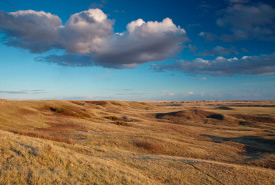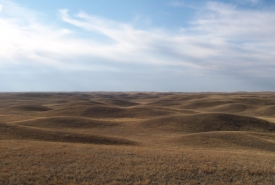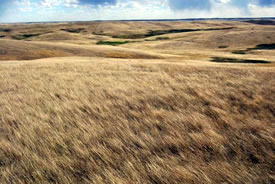For the love of prairies: celebrating Native Prairie Appreciation Week

Missouri Coteau, Saskatchewan (Photo by Branimir Gjetvaj)
Uncultivated, wild prairie wool has a certain beauty and grace about it, and somehow also a sense of timelessness. Prairie landscapes are dynamic and always changing in subtle ways, yet remain unchanged in many other ways.
There is an estimated 15 to 20 per cent of Saskatchewan’s native prairie remaining. Much of this habitat is fragmented into smaller parcels or bisected with corridors. Fortunately there are some larger, contiguous blocks of prairie wool in pockets across the province.
Land that was deemed too rocky, too desolate or not “productive enough” was left unploughed, and even referred to as wasteland — a rather desperate-sounding and unaffectionate term. The funny thing about this prairie wasteland,

Rolling prairie at Old Man on His Back Prairie and Heritage Conservation Area, SK (Photo by Branimir Gjetvaj)
though, is that it is able to sequester carbon and other nutrients. It provides critical habitat for pollinators, wildlife and species at risk. It can filter, buffer and improve water filtration. It is a highly valuable source of biodiversity, and it provides livestock with a varied and nutritious diet. Not to mention, it serves as a link to our natural history, plus a few dozen other ecological odds and ends. Not bad for a wasteland.
Some folks, like ranchers, respect and appreciate native prairie 365 days a year because it is a fundamentally important resource for their business and family. These brittle working landscapes provide beautiful settings to work in, yes, but ranchers require a large amount of perseverance (and capital) in order for them to rear livestock and make a living off of native prairie.
Other prairie enthusiasts, such as biologists and technical specialists, show their appreciation for prairies in odd ways. This may include speaking Latin when referring to prairie plants and animals, or conversing in three and four-letter acronyms, such as NAWCA or NPAW. Armed with quadrat frames, field guides, bug spray and sunscreen, they quantify plants and other species, looking for good, better or best indicators of trends and ecosystem dynamics.
One thing all prairie stakeholders have in common, regardless of whether they wear cowboy or hiking boots, is their ability to keep anyone apprised of the local tick situation on a tick-by-tick basis — better than anyone else. Trust me.

Buffalo Valley, SK (Photo by NCC)
Many people in Saskatchewan (or Canada, for that matter) have likely never set foot in a native prairie ecosystem and may not understand its importance. Far removed from natural ecosystems, as well as the food-producing sectors that are intertwined with them, today’s society perhaps doesn’t understand the intrinsic values that the prairie provides for everyone.
Every year, Saskatchewan proclaims the third week in June (this year June 15-21, 2014) as Native Prairie Appreciation Week to help generate awareness about this valuable natural resource. Fondly referred to as NPAW (here we go with the acronyms), it’s a time for students, biologists, prairie stakeholders, ranchers and ANYONE to come together to learn and share ideas and experiences about the prairie and its management.
We can all enjoy the prairie for one reason or another. Perhaps it reminds us of simpler times or the home of our youth, or perhaps it’s a favorite hunting or hiking trip that we’ve enjoyed. Maybe it inspires creativity within us, or resiliency. It’s worth taking time to appreciate native prairie and the species (including the humans!) that make their homes there. Mother Nature isn’t exactly making any more of it.

